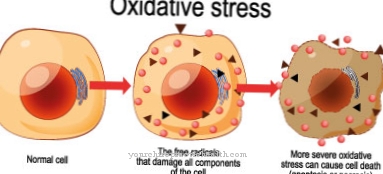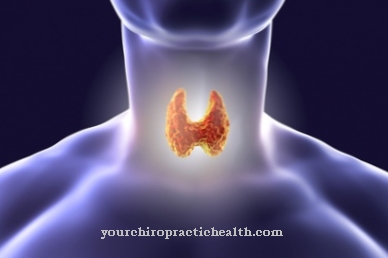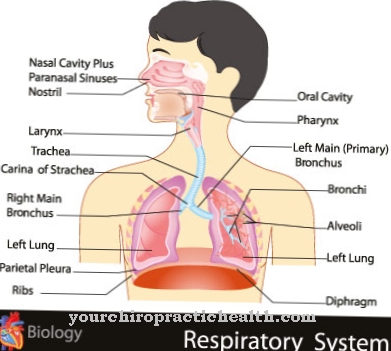If a child or baby has a fever with swelling on the extremities after a flu-like infection or a childhood illness that has already subsided, they should Henoch-Schönlein purpura be thought. This disease is also associated with punctiform skin hemorrhages, which sometimes also look like blood cells.
What is Henoch-Henoch Purpura?

© SciePro - stock.adobe.com
Henoch-Schönlein purpura is an inflammatory disease of the blood vessels caused by the immune system. In the run-up, there may initially be a slight fever and pain, later on, the small and medium-sized vessels in particular lose stability and the blood can penetrate the overlying skin.
The punctiform skin bleeding, which is also known as petechiae, is typical for this disease. In addition, there are swellings on the back of the feet and hands due to the accumulation of tissue fluid in these areas. The affected children are noticed by a sudden restriction of movement.
In some cases Henoch-Schönlein purpura can also cause inflammation of the kidneys or the intestines, as the disease can also manifest itself on the mucous membranes. This leads to bloody diarrhea and blood in the urine. The disease progresses in bouts that extend over several weeks. Children up to school age are particularly affected, but hardly any babies or young people.
causes
Henoch-Schönlein purpura is in most cases the result of a previous illness such as chickenpox, rubella or measles and occurs up to three weeks after these infections. Henoch-Schönlein purpura can also occur after a simple flu-like infection or after an infection with Influzena A virus and other diseases that primarily affect the upper respiratory tract.
The use of medication is very rarely the cause of this immune reaction. In individual cases there is therefore no recognizable cause for the occurrence of the disease. It is not yet known why Henoch-Schönlein purpura manifests itself. However, allergic reactions of the patient to the pathogens are suspected to be the trigger for the sudden inflammatory reactions.
Symptoms, ailments & signs
The first symptoms usually start suddenly. They don't show up continuously, but come in batches. The children feel sick, have a loss of appetite, stomach cramps and headaches. The characteristic signs of Henoch-Schoenlein purpura then follow: Small punctiform hemorrhages (petechiae) initially only a few millimeters in diameter.
Over time, they enlarge and combine to form larger spots. They are most commonly found on the buttocks and lower legs. They do not itch, cannot be pushed away, are slightly raised and palpable. As a rule, they are distributed symmetrically on the body. Furthermore, the petechiae can also develop in the digestive tract, which leads to bloody diarrhea and colic-like abdominal cramps.
They are also possible in the kidneys and cause bloody urine. When they affect the joints, there is restricted mobility and swelling, often in the knee and ankle joints. In boys they very rarely develop on the testicles or arms.
In exceptional cases, the brain can be affected by the petechiae, which leads to paralysis, seizures, or impaired consciousness. The extreme complication of the disease is when the spots begin to bleed and become necrotic, causing the tissue to die. In this case, the life of the child is in danger.
Diagnosis & course
Henoch-Schönlein purpura is diagnosed by the doctor based on the typical circular and merging skin bleeding. These occur on the lower abdomen and buttocks as well as on the lower legs and feet. In boys they can also be visible on the testicles. Other complaints such as abdominal pain and bloody diarrhea indicate intestinal involvement.
However, these symptoms do not appear until about one to two weeks after the skin reactions. A dysfunction of the kidneys is also possible after a delay. Then, in laboratory tests, blood and protein are found in the urine. In addition, blood pressure can also be increased. More than 30 percent of the sick children suffer from a kidney dysfunction during the course of Henoch-Schönlein purpura.
Complications
Henoch-Schönlein purpura leads to a number of different unpleasant symptoms in the patient. Usually this leads to bleeding on the skin. These can occur in different parts of the body and are often associated with pain. Likewise, the affected regions of the body are often swollen and pain in the joints occurs.
Due to the joint pain, the patients often suffer from restricted mobility and thus from difficulties in everyday life. Henoch-Schönlein purpura can also cause pain in the abdomen or stomach. Blood also appears in stool and urine. The blood pressure itself is also increased by Henoch-Schönlein purpura, so that other diseases can more easily develop.
Usually, no special treatment for this disease is necessary. With the help of bed rest and relaxation, the body can fight the disease. Medication can also continue to support treatment. There are usually no complications. The patient's life expectancy is also not affected by successful treatment of the disease. Without treatment, Henoch-Schönlein purpura can also lead to kidney failure.
When should you go to the doctor?
Medical treatment is always necessary for Henoch-Schönlein purpura. There is no self-healing in this disease and the disease can usually not be treated by means of self-help. Further complications and complaints can only be prevented through medical treatment. A doctor should be consulted if the person concerned suffers from severe pain in the abdomen and loss of appetite. This can also lead to pain in the head or small bleeding all over the body.
If these symptoms persist and do not go away on their own, a doctor must be consulted in any case. Henoch-Schönlein purpura must also be treated with severe diarrhea. Furthermore, swelling or restrictions in movement can indicate the disease and should be examined by a doctor. The sooner Henoch-Schönlein purpura is treated, the higher the likelihood of a complete cure. In the worst case, the tissue can die off completely.
Treatment & Therapy
Henoch-Schönlein purpura in most cases heals on its own in a few days. There are no drugs that specifically target this condition. To protect yourself, the child should keep bed rest. In the case of bloody diarrhea, the immune reaction is weakened with cortisone so that the intestine can recover.
Treatment is more difficult when kidney function deteriorates. In the case of Henoch-Schoenlein nephritis, a kidney biopsy must be used to determine the severity of the disease. The administration of cortisone or other drugs that artificially suppress the immune system can improve kidney function. An increased blood pressure resulting from kidney disease is also treated with appropriate medication.
With this severe course of Henoch-Schönlein purpura, it takes about four to six weeks for the child to fully recover. After the disease, kidney function must be checked at regular intervals for several years, as it may deteriorate again as the disease progresses. The occurrence of kidney failure or shock from sudden, extensive skin bleeding is extremely rare. Henoch-Schönlein purpura can recur in children.
You can find your medication here
➔ Drugs for wound treatment and injuriesprevention
There are no preventive measures Henoch-Schönlein purpura. If unusual skin conditions are discovered in babies and younger children, a doctor should be consulted as soon as possible. This ensures monitoring in the event of a possible severe course of Henoch-Schönlein purpura.
Aftercare
Henoch-Schönlein purpura does not require any special causal follow-up care. Since it is a multisystem disease, there may be various complaints that are treated symptomatically. In severe cases of the disease, cortisone therapy can be prescribed. It may also be necessary to prescribe immunosuppressive drugs. In addition, the use of painkillers can be advised in the event of pain and persistent itching. Antipruritic ointments can also be used as a support.
After the illness, those affected should take it easy, stay in bed if necessary, and avoid intense physical activity. Fish oil capsules can have a positive effect on healing. Tight clothing should also be avoided so that the skin can also recover.
If kidney function is impaired or kidney failure caused by advanced Henoch-Schönlein purpura, a kidney transplant or lifelong dialysis is necessary. Since this disease has an increased tendency to relapse, regular check-ups are necessary for up to two years. Above all, the kidney function is checked with the help of regular urine samples.
The prognosis for Henoch-Schönlein purpura, especially in children, tends to be positive. The healing takes place within one to several months. The later quality of life is basically not influenced in mild to normal cases. Exceptions are cases in which kidney damage occurred.






.jpg)


















.jpg)


